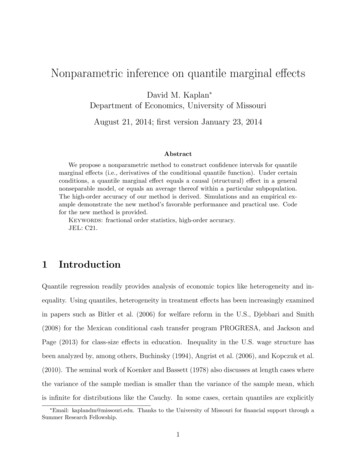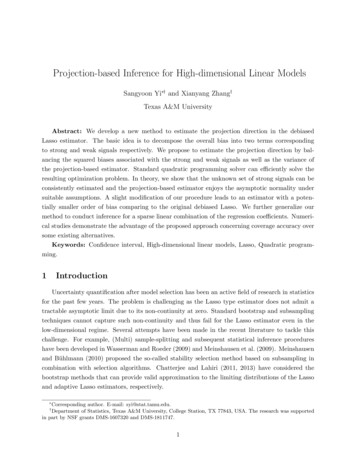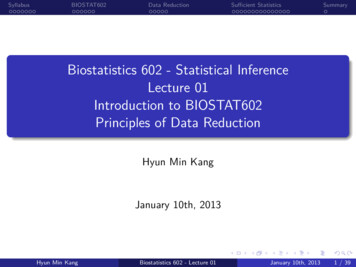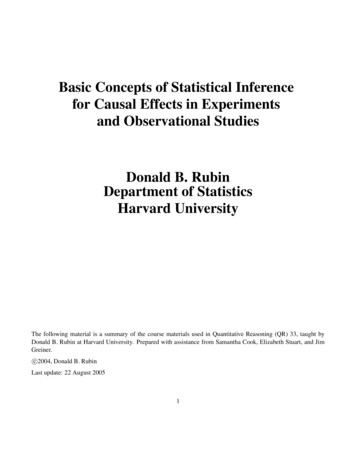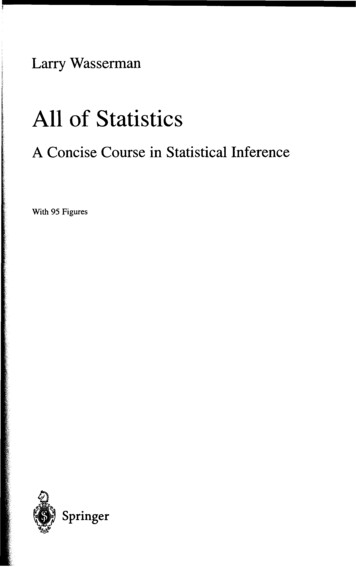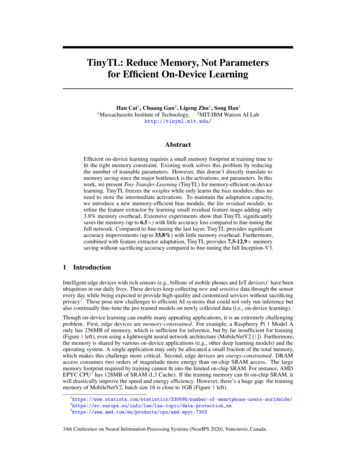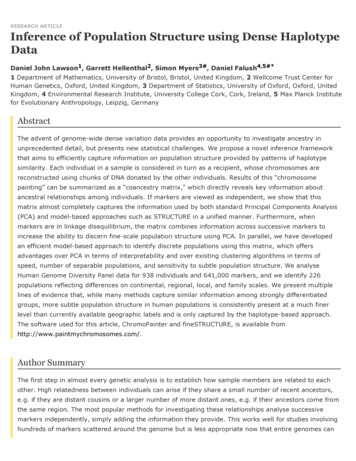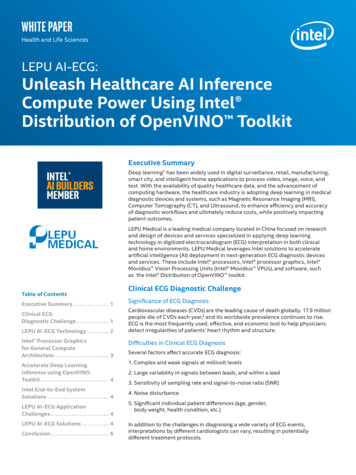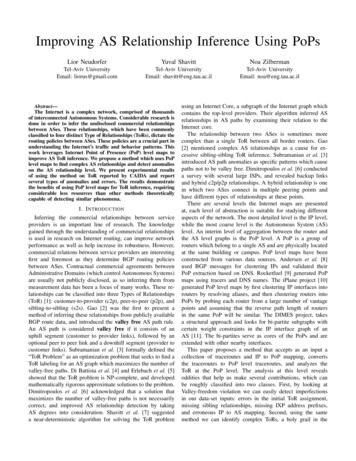
Transcription
Improving AS Relationship Inference Using PoPsLior NeudorferYuval ShavittNoa ZilbermanTel-Aviv UniversityEmail: liorus@gmail.comTel-Aviv UniversityEmail: shavitt@eng.tau.ac.ilTel-Aviv UniversityEmail: noa@eng.tau.ac.ilAbstract—The Internet is a complex network, comprised of thousandsof interconnected Autonomous Systems. Considerable research isdone in order to infer the undisclosed commercial relationshipsbetween ASes. These relationships, which have been commonlyclassified to four distinct Type of Relationships (ToRs), dictate therouting policies between ASes. These policies are a crucial part inunderstanding the Internet’s traffic and behavior patterns. Thiswork leverages Internet Point of Presence (PoP) level maps toimprove AS ToR inference. We propose a method which uses PoPlevel maps to find complex AS relationships and detect anomalieson the AS relationship level. We present experimental resultsof using the method on ToR reported by CAIDA and reportseveral types of anomalies and errors. The results demonstratethe benefits of using PoP level maps for ToR inference, requiringconsiderable less resources than other methods theoreticallycapable of detecting similar phenomena.I. I NTRODUCTIONInferring the commercial relationships between serviceproviders is an important line of research. The knowledgegained through the understanding of commercial relationshipsis used in research on Internet routing, can improve networkperformance as well as help increase its robustness. However,commercial relations between service providers are interestingfirst and foremost as they determine BGP routing policiesbetween ASes. Contractual commercial agreements betweenAdministrative Domains (which control Autonomous Systems)are usually not publicly disclosed, as so inferring them frommeasurement data has been a focus of many works. These relationships can be classified into three Types of Relationships(ToR) [1]: customer-to-provider (c2p), peer-to-peer (p2p), andsibling-to-sibling (s2s). Gao [2] was the first to present amethod of inferring these relationships from publicly availableBGP route data, and introduced the valley free AS path rule.An AS path is considered valley free if it consists of anuphill segment (customer to provider links), followed by anoptional peer to peer link and a downhill segment (provider tocustomer links). Subramanian et al. [3] formally defined the“ToR Problem” as an optimization problem that seeks to find aToR labeling for an AS graph which maximizes the number ofvalley-free paths. Di Battista et al. [4] and Erlebach et al. [5]showed that the ToR problem is NP-complete, and developedmathematically rigorous approximate solutions to the problem.Dimitropoulos et al. [6] acknowledged that a solution thatmaximizes the number of valley-free paths is not necessarilycorrect, and improved AS relationship detection by takingAS degrees into consideration. Shavitt et al. [7] suggesteda near-deterministic algorithm for solving the ToR problemusing an Internet Core, a subgraph of the Internet graph whichcontains the top-level providers. Their algorithm inferred ASrelationships in AS paths by examining their relation to theInternet core.The relationship between two ASes is sometimes morecomplex than a single ToR between all border routers. Gao[2] mentioned complex AS relationships as a cause for excessive sibling-sibling ToR inference. Subramanian et al. [3]introduced AS path anomalies as specific patterns which causepaths not to be valley free. Dimitropoulos et al. [6] conducteda survey with several large ISPs, and revealed backup linksand hybrid c2p/p2p relationships. A hybrid relationship is onein which two ASes connect in multiple peering points andhave different types of relationships at these points.There are several levels the Internet maps are presentedat, each level of abstraction is suitable for studying differentaspects of the network. The most detailed level is the IP level,while the most coarse level is the Autonomous System (AS)level. An interim level of aggregation between the router andthe AS level graphs is the PoP level. A PoP is a group ofrouters which belong to a single AS and are physically locatedat the same building or campus. PoP level maps have beenconstructed from various data sources. Andersen et al. [8]used BGP messages for clustering IPs and validated theirPoP extraction based on DNS. Rocketfuel [9] generated PoPmaps using tracers and DNS names. The iPlane project [10]generated PoP level maps by first clustering IP interfaces intorouters by resolving aliases, and then clustering routers intoPoPs by probing each router from a large number of vantagepoints and assuming that the reverse path length of routersin the same PoP will be similar. The DIMES project, takesa structural approach and looks for bi-partite subgraphs withcertain weight constraints in the IP interface graph of anAS [11]. The bi-partites serve as cores of the PoPs and areextended with other nearby interfaces.This paper proposes a method that accepts as an input acollection of traceroutes and IP to PoP mapping, convertsthe traceroutes to PoP level traceroutes, and analyzes theToR at the PoP level. The analysis at this level revealsoddities that help us make several contributions, which canbe roughly classified into two classes. First, by looking atValley-freedom violation we can easily detect imperfectionsin our data-set inputs: errors in the initial ToR assignment,missing sibling relationships, missing IXP address prefixes,and erroneous IP to AS mapping. Second, using the samemethod we can identify complex ToRs, a holy grail in the
2field. An interesting subgroup of complex ToRs we identifiedare "academic oddities": cases where academic networks donot follow the strict commercial rules of relationships. Whilesome of our findings can be achieved at the IP level, we pointout that the analysis at the PoP level dramatically reduces theprocessing amount.II. A NALYSIS P ROCESSAs said above, this paper proposes a method for inferringToRs at the PoP level, and for discovering anomalies thatlead to improvements of its input data (ToRs, IP to ASmapping) as well as revealing complex AS relationships. Westart by converting a traceroute dataset to a PoP level traceroute(preprocessing); then we deduce missing ToRs, based on theones we have; and finally we flag out anomalous ToRs, someof which are clear suspects of complex ToRs. Some of theanomalies we find in the last stage are errors in our inputdatasets, which are then corrected for future use. Thus, aswe keep using the analysis method periodically, we end upflagging only true anomalies and new changes in the InternetToRs (like a new merger between two ASes). A detaileddescription of the method stages is as follows:A. PreprocessingThe algorithm receives as inputs:1) A dataset of IP-level traceroute measurements.2) A mapping of IP addresses to PoPs and ASes.3) A dataset providing initial classification of AS-levellinks ToR: c2p / p2c / p2p / s2s.The first step of the preprocessing is identifying for each IPaddress in the traceroutes dataset its corresponding PoP andAS. IP addresses whose AS can not be identified (i.e., internalIP addresses) are discarded. IP addresses whose AS is knownbut their PoP is not are retained. The next step is identifyingthe path’s AS borders, by finding pairs of consecutive hopswhich belong to different ASes. All IP-level hops which arenot located on AS-AS border links are discarded, as weare only interested in links between different ASes. Finally,the algorithm discards repeating paths and paths which arefully contained within other paths. This last stage reducesthe amount of paths, leaving only paths that contribute newinformation over others.Traceroute paths may contain PoP loops or cycles, causedby load balancing artifacts, misconfigured routers or measurements taken during routing convergence periods [12]. For anypath that contains a loop, the algorithm trims the path’s prefixand suffix in order to retrieve the longest possible segmentwhich does not contain a loop. We discard traceroute measurements which, when repeatedly measured, show artifactsof load-balancing routers.The last step in the preprocessing stage is discarding IXPhops from the traceroutes. As some IXPs appear on traceroutepaths as an additional AS hop, they may introduce errors in thefollowing phases. Thus, if hop N in the traceroute representsan IXP, we drop this hop and stitch hops N 1 and N 1together, forming as AS-to-AS level link. We further discussthe reason and effect of this step in section IV.B. ToR augmentationThe ToR augmentation method, which is based on ideasfrom [7], assumes validity of the valley-free rule on existingpaths and infers new ToRs in a way which preserves this rule.This assumption is used to assign a ToR to links that have noToR classification in the initial ToR database.To find the ToR of unclassified links, we consider AS-levellink paths generated in the preprocessing stage. Only AS-levellink paths that have a single unclassified link and that areotherwise valley-free are considered. For each undeterminedlink in a given path, a vote is cast for each type of ToR whichwill not violate the valley-free path property: A c2p vote iscast for links which are in the middle of an “uphill” segmentor links between an uphill segment and a p2p link. A p2cvote is cast for links which are in the middle of an “downhill”segment or links between a p2p link and downhill segments.For links which are before downhill segments in a path whereonly a downhill segment is detected, or which are after uphillsegments in a path where only an uphill segment is detected,two votes are casted - one for p2c and one for c2p. For linkswhich are located exactly between the uphill and downhillsegments, All three possible votes are casted: c2p, p2p andp2c.After traversing all eligible paths, a new ToR is inferredfor cross-AS PoP-links that had no ToR assigned. Such a linkis assigned a ToR if the percentage of votes which agreedon a ToR is larger than a VOTING - THRESHOLD, and therewere more than MIN - VOTES votes for the ToR. In case thatmultiple ToRs pass the above thresholds, we give precedenceto the p2p ToR. The process is then repeated, taking newlydiscovered ToRs into consideration, and trying to infer ToRfor the remaining unassigned links, until no new ToRs arediscovered.C. Complex ToRs and anomaly detectionA path which is not valley-free and can be corrected bychanging a single link’s ToR, is termed a single-error path.Single-error paths always contain one or two links whose ToRcan be changed in order to make the path valley-free (a proofis omitted due to space limitation). These links are denotedcandidate anomalous links. Each candidate anomalous link hasone or two alternative ToRs: the ToRs which if assumed willmake the path valley-free. For each PoP-PoP link A-B, thealgorithm finds:1) P : the group of paths that link A-B is part of.2) n: the overall number of unique PoP and AS nodes inthe graph created by combining all the paths that containlink A-B. A larger number means A-B was measuredby many traceroutes, with many diverse sources anddestinations.3) V P : the group of valley-free paths A-B is part of.4) F Pc2p : the group of paths which are not valley-free, inwhich A-B is a candidate anomalous link, who can be
3made valley-free by assuming c2p ToR for A-B. F Pp2pand F Pp2c are defined similarly.The algorithm outputs anomalous PoP-PoP links which satisfythe following conditions: The link has a minimal measurement tree size (n min-nodes) The percentage of valley-free paths containing thelink is smaller than an arbitrary min-valid-percentage( V P / P max-valid-percentage) There is a new ToR which, when assumed for thelink, turns a large percentage of paths to be valley free( F PT oR / P min-f ixed-percentage)The three conditions capture cases when a PoP-PoP link hasa significant evidence for a problem (first two conditions) anda fix in the link ToR, which seems to correct the problem. Thealgorithm also outputs the set of PoP-level links which complywith the first two rules, but for which a new ToR could notbe determined with a high level of confidence.III. DATASETSThree types of datasets are used in this study:DIMES traceroutes All the traceroutes measurements aretaken from the DIMES project [13], from May 2012, weeks19 and 20. The dataset includes 29.2 million traceroute measurements and 506.3 million IP-level hops. The measurementstargeted 2.39 million destination IP addresses and were collected by 1017 DIMES agents. RouteViews [14] and WHOISdatabases were used to infer every IP address to an AS.DIMES PoPs The IP to PoP mapping dataset is taken fromthe DIMES project, from weeks 19 and 20 of 2012. Themapping was based on traceroutes taken by both DIMES andiPlane [10] over the same period of time. The map contains5215 PoPs and 98650 IP addresses in 2636 different ASes. Itis publicly available on the DIMES project website.CAIDA ToRs The initial AS ToR mapping dataset is takenfrom CAIDA’s AS Rank Website1 at August 2012. The datasetrelies on BGP paths obtained on June 2012. It containsToRs for 119, 924 AS couples. 76781 (64%) relationshipsare customer/provider relationships, 40,900 (34%) are peeringrelationships and 2243 (2%) are sibling relationships.IV. E XPERIMENTAL R ESULTSA. Preprocessing Results and ToR augmentationThe preprocessing stage of the algorithm takes the 29million IP level traceroute measurements and turns them into1.63 million unique PoP level paths, thus reducing the datasetsize by an order of magnitude. 1.48 million PoP-level Paths(91%) are valley free.Out of the 70714 AS-AS link found in the dataset, only45202 links (64%) were covered by the CAIDA dataset. Itis thus necessary to augment the ToR dataset. We completethe missing ToR for 6699 links and fail to complete 18813AS-AS links, out of them 495 appear only on paths whichare not valley free. Links of unknown ToR which appear only1 http: //www.caida.org/data/active/asrelationships/on paths which are not valley-free can not be assigned a ToRwith a high level of confidence. The augmentation increasesthe number of customer-provider PoP links but only slightlyincrease the number of peer-peer links. For the ToR voting,we use a VOTING - THRESHOLD of 80%, which gives a highlevel of confidence that the inference is correct. We select thisvalue based on experimentation with a range of values and findthat the effect on the results is marginal. Further informationis omitted due to space limitations.The ToR augmentation method requires a minimal numberof paths in which the inferred AS-AS link is included and thatare valley-free, the MIN VOTES threshold. This parameter isrequired as inferring ToRs according to a few paths mightintroduce errors due to wrong traceroute replies or wrongAS prefix resolution, similarly to the phenomena describedby Zhang et al. [15]. We tested a range of MIN - VOTES values,in order to select the best threshold and to verify sensitivity.Setting MIN - VOTES 5 infers 6699 new ToRs, while MIN VOTES 3 helps inferring 8594 new ToRs. However, for alarge number of AS-AS links there is only a single applicablepath (regardless of the valley free rule), which makes theaugmentation difficult. Under such conditions we do notattempt to infer the ToR. For lack of space we omit furtherdiscussion of MIN - VOTES sensitivity. We eventually set MIN VOTES 5 which is a high confidence threshold, and allowsto infer 26% of the missing ToRs.B. Sensitivity analysisTwo parameters affect the anomaly detection method. Thefirst, min-valid-percentage, determines the minimal percentageof valley-free paths required to consider the PoP-PoP ToRcorrect (as detailed in Section II-C). The second parameter,min-fixed-percentage, determines the minimal percentage ofvalley-free paths after the ToR was replaced required toconsider the new PoP-PoP ToR correct. We evaluate the effectthese two parameters have on our anomaly detection method’sresults.min-valid-percentage and min-fixed-percentage capture theamount of confidence we wish to achieve in determiningwhether a specific PoP-PoP link is anomalous. A larger minvalid-percentage may cause non-anomalous links to appear asanomalous, but can also lead to the discovery of anomalouslinks that by chance did not consistently cause path invalidity.A low min-fixed-percentage threshold marks PoP-PoP linksthat even after changing their ToR appear as candidates tobe anomalous due to non valley-free paths. This may happenwhen some of the paths contain other errors, such as traceroutemeasurement errors resulting from wrong AS resolution orToR errors on other AS-AS links.To study the sensitivity to thresholds, we omit anomaliesthat turn out to be errors in the original AS ToR databaseor that are caused by IXPs. This is done as these are onetime corrections and do not affect the algorithm in later runs.Figure 1 shows the effect of changing the two parameters onthe number of discovered anomalous PoPs, with min-nodesset to 10 nodes. For the purpose of sensitivity study, we
4Figure 1.Anomaly Detection vs. Thresholds Values.consider as anomalous PoPs only PoPs that fall under thecategories of complex AS relationships and odd academicToRs (see below). Clearly for a large range, between 0%and 35% for the min-valid-percentage threshold and between70% and 100% of the min-fixed-percentage threshold, there islittle change in the number of discovered anomalies. Thus, Weselect the thresholds from the non-sensitive region: min-validpercentage 20% and min-fixed-percentage 75%.An interesting observation is that eight PoP couples are"perfect anomalies": they appear in no valid PoP paths, butwhen changing their ToR all the paths in which they appearbecome valley-free.C. Anomaly detectionAfter the first execution of the anomaly detection algorithm,we detect a couple of dozens anomalies. We classify theseanomalies into seven categories and highlight specific casesthat exemplify the anomaly type:1) AS Prefix Resolution Errors: Our anomaly detectionmethod detected three cases that were attributed to AS prefix resolution errors. In these cases, the corresponding ASfor a specific IP address in a traceroute measurement wasincorrectly resolved by the RouteViews dataset. This caused alarge percentage of the paths which contained this address tocontain a valley, as the ToR between the wrongly assigned ASand its neighbors was incorrect. AS prefix resolution errorsmight occur when the BGP blocks that were announced toRouteViews were incorrect or not updated. Closer inspection,using other tools such as WHOIS, revealed the true owner ofthe IP address. Assessing the accuracy of multiple IP to ASresolution databases is outside the scope of this paper.Figure 2 demonstrates this phenomenon. In this case, ananomalous link is detected between AS2116 (Ventelo) andAS3549 (Global Crossing), AS3549 is the provider accordingto CAIDA. In all the paths that contained this link, it appearedafter a link between AS3356 (Level 3) and AS2116 (Ventelo),which is a p2c link, creating a valley in these paths. However,using WHOIS it was discovered that the IP prefix to ASmapping was wrong, and that the PoP first associated withFigure 2. AS Prefix Resolution Error- ExampleFigure 3. Complex AS Relationship- ExampleAS3549 actually belongs to Domenenshop (AS12996), whichis a customer of Ventelo.2) IXP and sibling detection: Usually, when IXPs appear intraceroute paths it is as an additional IP hop. In ToR analysisthey should be removed or else introduce errors since theyare not part of the AS hierarchy, which we did in our preprocessing stage using lists of known IXPs. However, we havefound six IXPs that appeared as anomalies in our PoP leveltraceroutes. Finding IXPs and consequently other anomaliesis an incremental process, as each detected IXP allows morepaths to become valley-free (due to their omission).Similarly, we detected wrongly inferred siblings relationships. These are often cases of one ISP taking over a secondISP, which was previously its customer. This change of ToR isnot always updated in the ToR dataset. Thus, when checkingvalley free routing, some of the paths between the pair of ASeswill remain valid as c2p, while others will only be valid as s2s.Since in many routes a s2s ToR is interchangeable with c2pToR, the change of ToR between the two ASes may be hard todetect. We manage to find 6 wrongly inferred s2s relationships,e.g., between TelePacific (AS14265) which acquired Mpower(AS18687).3) ToR inference errors: On three cases, a PoP-PoP linkwas deemed anomalous, but closer inspection revealed that theToR for the corresponding AS-AS link was wrongly inferredby CAIDA. In general, the method tries to avoid flaggingsuch cases as anomalies. It does so by discarding anomalouscandidate links for which the confidence for correspondingASes’ ToR is not high enough. We deem two ASes’ ToR asconfident if there is a majority of paths containing the AS-ASlink which follow the valley-free rule.Two of the three cases we’ve discovered were corrected inCAIDA’s ToR dataset a few weeks following this analysis. In
5the third case, CAIDA inferred a peering relationship betweentwo ASes (AS12389 and AS8359), while in our measurementsalmost half of the paths which contained this AS-AS link werenot valley free.One exemplary case of a wrongly inferred ToR, CAIDAinferred the AS3561-AS4134 (SAVVIS-Chinanet) as a peeringrelationship. Our algorithm detected specific PoPs belongingto these organizations as anomalous, and suggested a p2crelationship instead. The PoPs were deemed anomalous asthere was a small majority of paths containing PoP couplesfrom AS3561 and AS4134 (80 out of 145 paths) which werevalley free. A few weeks following this analysis, CAIDAupdated this ToR in their dataset and changed the relationshipbetween the two ASes to p2c, same as suggested by ouralgorithm.4) ComplexASrelationships:Aninterestingrelationship was found between two PoPs of AS3561(SAVVIS/CenturyLink) and AS6453 (TATA) in Canada. Asboth ASes are Tier-1 providers, the assumed ToR betweenthem is a peering relationships (also indicated by CAIDA).However, only three out of the sixteen unique PoP paths thatinclude a link between this pair of PoPs are valley-free. Outof the remaining 13 paths, 11 traverse a PoP link betweenAS174 (Cogent) and AS6453 (TATA), clearly another p2plink between tier-1 ASes (see Figure 3). When assuming ac2p relationship (the provider being AS6453’s PoP), all pathsare valley-free.It seems that while CenturyLink and TATA have a peeringrelationship in most locations, this specific PoP-PoP link isconfigured differently: TATA’s specific PoP provides transitservices between other Autonomous Systems (namely, Cogent)and SAVVIS.We have revalidated this finding a couple of weeks afterthe original experiment’s date, by running a dedicated DIMESexperiment that, issuing a large amount of traceroute measurements towards the specific IP addresses of these PoPs frommany widely spread vantage points. The phenomenon was alsoreproducible by issuing traceroutes from Cogent routers, usingtheir Looking Glass service.5) Odd Academic ToRs: A couple of ToR anomalies arediscovered in research institutes’ affiliated PoP links. Researchinstitutes are less driven by commercial incentives and tend tobe more collaborative in nature, thus setting their ToR criteriadifferently than most ASes.Figure 4 shows one such case, involving multiple PoPsbelonging to research organizations. Traffic flowed from multiple PoPs belonging to SWITCH, the Swiss Education andResearch Network (AS559) through CERN (AS513) and thenthrough KPN (AS286), finally reaching the tier-1 providerLevel3 (AS3356). According to the ToRs inferred by CAIDA,SWITCH is a provider of CERN, and KPN is a peer ofLevel3, causing this path to be non valley-free. CAIDA’sdataset missed information on the ToR of CERN and KPN,but for any ToR this path violates the valley-free rules.An additional anomaly, shown in Figure 5, is a single HP(AS71) PoP that is connected to the Internet via StanfordFigure 4.AcademicAnomaly - First ExampleToRFigure 5.Academic ToRAnomaly - Second ExampleUniversity (AS32) and CSUNET (AS2153). CAIDA’s ToRfor the HP-Stanford link was p2p, and the Stanford-CSUNETlink was c2p (Stanford is the customer), resulting in a clearanomalous link.6) Traceroute errors: We have found three cases in whichwe believe detected anomalies were probably caused by wrongrouter replies. In these cases, a specific IP address which waspart of a reported traceroute path was not the actual IP addresstraversed by traffic on this path. This is caused by ICMPreplies that are sent through a different interface than the onethe packets actually went through [16]. This error may resultin a wrong AS resolution, leading to wrongly assumed nonvalley free paths.7) Unresolved Anomalies: Three of the anomalies we foundremain unresolved. While we have assumptions for the natureof these anomalies, we did not manage to corroborate ourfinding and thus prefer to declare them unclassified.D. Discussion1) ToR Datasets: AS ToR datasets fail to capture a largeamount of AS links, due to their reliance on specific datasources. For example, CAIDA’s AS Relationships Dataset [17]only uses BGP routes in order to infer AS ToRs. Shavittand Shir [13], and more recently Gregori et al. [18], showedthat BGP and traceroute measurement sources complementeach other. Therefore, our augmentation of an existing ASToR dataset according to an additional source of traceroutemeasurements is important by itself.2) ToR inference at different layers of aggregation: Tobetter understand the contribution of PoP level maps to ToRresearch, the disadvantages in using other levels of aggregationshould be discussed in comparison.For many years, using the AS level graph to infer ToRsseemed to be the right way, as this is seemed to be the level atwhich ToRs are defined. In addition, the AS graph is relativelysmall and easy to study. However, the AS level treatment doesnot allow the inference of complex relationships, where twoASes have different relationships in two different locations.As demonstrated by Dimitropoulos et al. [6], ASes mighthave a more complex relationship in various peering points.
6In addition, most existing algorithms use specialized methodsfor sibling relationship detection, which rely on data sourcesother than BGP and traceroute measurements [17].Using router or IP level maps for complex relationshipdetection is also not a good solution as it is hard to identify inthem scattered errors and anomalies. IP level paths introducenoise to the measurements and cause anomalies to be dispersedover multiple IP addresses, diminishing their significance andpreventing their accurate detection. In addition, router andIP level datasets are very large and require considerableprocessing resources.PoP level maps provide an answer to the above issues andpropose a better level of aggregation than AS, Router or IPlevel for anomaly detection. If two ASes have different relationships in two different locations, these will be representedby two distinct PoP-PoP links, and one of them will clearlyviolate the valley free rules, and thus can be easily flagged.While the same information will also be detectable on theIP/router level, it will be hard to correlate it to a specificlocation and to discard local errors. Considering the sameproblem the other way around, when detecting on the IP/routerlevel multiple non valley free routes it is hard to understandthe nature of each link’s anomaly or error. The aggregationof multiple IP/router level links to a single PoP-PoP linkreduces the complexity of this issue considerably, and providesa higher level of confidence to the inferred new ToR.3) Dataset Size Dependence: ToR Errors and PoP-PoPlink anomalies are more likely to be found as we increasethe number of measurements and diversify the measurementvantage points. When measured from a small number ofsources, an anomaly might not be identified, since a single pathmight not violate valley-freedom even with the existing erroror anomaly. For example, if a ToR is inferred as p2p insteadof c2p, it might not be discovered if the link resides betweena c2p link and a p2c link. These paths would be valley-free inboth cases, and our method - which looks for improvement inthe percentage of valley-free paths when assuming a differentToR - would not identify this anomaly.It is important to note that anomalies detected in a givendataset on the PoP level will remain valid even if the datasetgrows considerably, since the threshold to flag an anomalousToR is based on the number of violating PoP level paths andnot their percentage.4) Validation: The validation of our method is a hard task.Except for verifying results with ISPs, which are reluctantto cooperate, there is no single ground truth dataset. As weshow, many of the datasets that we use as a reference haveerrors. Some of our results are corroborated by correctionsdone to the CAIDA dataset shortly after we ran our analysis.Another mean of validation is from ISPs websites and publicinformation. This applies mainly for siblings ToR validation,often caused by one ISP acquiring another.Another method of validation is using targeted measurements through many scattered vantage points to the point ofanomaly. This is intended to eliminate transient routing effectsand to confirm the anomaly through as many distinct pathsas possible. For some anomalies, such as mistakes in ASresolution, reverse DNS and WHOIS, are useful tool in findingthe true IP to AS mapping.We believe that the level of validation provided in this workis sufficient under the given lack of ground truth conditionsand as the results show, it provides a good mean to validateother datasets and sources for ToR information.V. C ONCLUSIONSin this paper we presented a method to infer AS relationships usi
while the most coarse level is the Autonomous System (AS) level. An interim level of aggregation between the router and the AS level graphs is the PoP level. A PoP is a group of routers which belong to a single AS and are physically located at the same building or campus. PoP level maps have been constructed from various data sources. Andersen .
